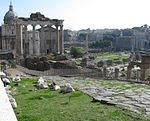Forum Boarium

The Forum Boarium (Classical Latin: [ˈfɔɾʊ̃ˑ boˈäːɾiʊm], Italian: Foro Boario) was the cattle forum venalium of ancient Rome. It was located on a level piece of land near the Tiber between the Capitoline, the Palatine and Aventine hills. As the site of the original docks of Rome (Portus Tiberinus), the Forum Boarium experienced intense commercial activity. The Forum Boarium was the site of the first gladiatorial contest at Rome which took place in 264 BC as part of aristocratic funerary ritual—a munus or funeral gift for the dead. Marcus and Decimus Junius Brutus Scaeva put on a gladiatorial combat in honor of their deceased father with three pairs of gladiators. The site was also a religious centre housing the Temple of Hercules Victor, the Temple of Portunus (Temple of Fortuna Virilis), and the massive 6th or 5th century BC Great Altar of Hercules.
Excerpt from the Wikipedia article Forum Boarium (License: CC BY-SA 3.0, Authors, Images).Forum Boarium
Via di Ponte Rotto, Rome Municipio Roma I
Geographical coordinates (GPS) Address External links Nearby Places Show on map
Geographical coordinates (GPS)
| Latitude | Longitude |
|---|---|
| N 41.888888888889 ° | E 12.481111111111 ° |
Address
Foro Boario
Via di Ponte Rotto
00153 Rome, Municipio Roma I
Lazio, Italy
Open on Google Maps










